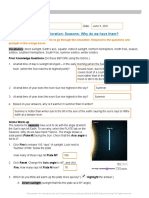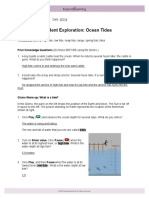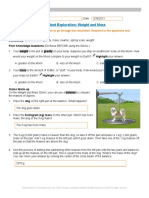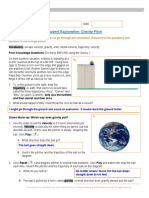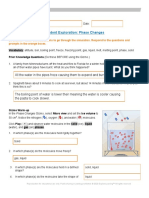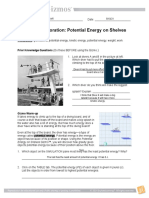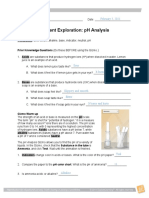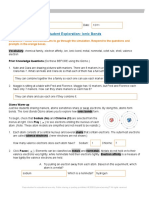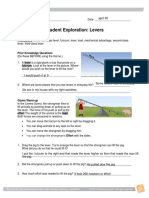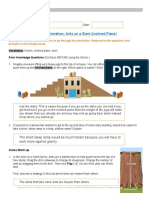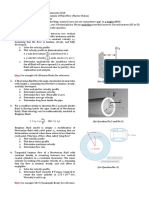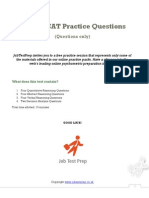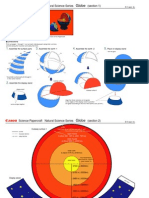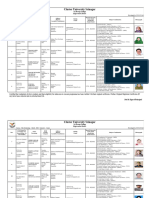29%(7)29% found this document useful (7 votes)
19K viewsModule 3 Lesson 1 Mastery Assignment 2 - Elijah Shuford
Elijah Shuford completed a student exploration on gravity and orbits using a simulation. They observed how changing a planet's mass and radius affected the trajectory of a pitched ball. Increasing a planet's mass strengthened its gravity, pulling the ball further, while increasing radius weakened gravity. The strongest gravity was from a custom planet with high mass and small radius. Escaping a planet required the highest velocity, with Mars having the lowest escape velocity.
Uploaded by
Tawanda Boone-ShufordCopyright
© © All Rights Reserved
Available Formats
Download as DOC, PDF, TXT or read online on Scribd
29%(7)29% found this document useful (7 votes)
19K viewsModule 3 Lesson 1 Mastery Assignment 2 - Elijah Shuford
Elijah Shuford completed a student exploration on gravity and orbits using a simulation. They observed how changing a planet's mass and radius affected the trajectory of a pitched ball. Increasing a planet's mass strengthened its gravity, pulling the ball further, while increasing radius weakened gravity. The strongest gravity was from a custom planet with high mass and small radius. Escaping a planet required the highest velocity, with Mars having the lowest escape velocity.
Uploaded by
Tawanda Boone-ShufordCopyright
© © All Rights Reserved
Available Formats
Download as DOC, PDF, TXT or read online on Scribd
You are on page 1/ 10
Name: Elijah Shuford
Format responses in med blue bold font.
Student Exploration: Gravity Pitch
Define Vocabulary:
escape velocity: the speed an object must travel to escape the gravitational pull of a planet.
ravity: the force of attraction between all objects in the universe.
orbit: the path of a celestial body (such as a moon or a planet) around another body
orbital velocity: the speed an object must travel to achieve a perfectly circular orbit
trajectory: the path of an object through space
velocity: an objects speed and direction of motion
Prior !no"lede #uestions (Do these BF!" using the #i$mo.)
!n their summer vacation% a family is standing at a scenic overloo& at the top of a tall cliff.
'oung (lice (age )) tosses a roc& over the edge and giggles as she watches it fall. Brother
Darrell (age *) thin&s he can do better and hurls another roc& over the edge. +apa Billy
chuc&les% pic&s up a nice round roc&% and flings it off the cliff as hard as he can.
,. -n the picture to the right% draw the
trajectory% or path% that each roc&
would ta&e. .abel the three
trajectories /(lice0% /Darrell0 and
/Billy0 (or just (% D and B).
$lice % purple
Darrell % red
Papa &illy ' reen
). 1hat would happen if Billy could
throw the roc& as fast as a roc&et2
( miht o throuh the round and
cause an explosion. (t "ould reach the
round faster.
Gi)mo *arm'up: *hich "ay does ravity pull+
,. 3se the slider to set the Velocity to 4.4 &m5s (&ilometers
per second). Velocity is basically the same thing as speed%
but has direction as well. -n this case the pitcher is simply
dropping the ball. 6lic& Play ( ).
(. 1hat direction does the ball go2
,he ball oes straiht do"n.
B. 7&etch the pitcher and the trajectory of the ball on
the diagram.
). 6lic& -eset ( ) and drag the pitcher to several new positions. 6lic& Play and watch him
drop the ball each time. 7&etch the pitcher and the trajectory of each ball on the diagram.
(. 1hat do you notice2 No matter "here ( move him the ball drops straiht do"n to
his feet.
B. 8he ball is pulled by a force called ravity. -n what direction does gravity always pull
the ball2 Gravity al"ays pulls the ball to"ards the center of the Earth.
$ctivity $:
.o" far does it
o+
#et the #i$mo ready:
6lic& -eset.
Drag the pitcher bac& to the top.
7et the Velocity to ,.4 &m5s ()%)9) miles per hour).
#uestion: *hy do objects o around/ or orbit/ other objects+
,. !bserve : 6lic& Play and observe the trajectory of the ball.
(8he pitcher is rather tall : about ,;44 &m% or <94 miles% tall=)
). +redict : >ow would the trajectory of the ball change as the
pitcher throws it harder and harder2 ?plain below% and
draw several predicted trajectories on the diagram.
,he ball may o out a little farther because there is more
force behind the thro".
9. 6ollect data : 8hrow the ball at velocities of )% 9% @% ;% A% and B &m5s. 3se the 0ast for"ard
button ( ) to speed things up and the /%0 $oom control to see a larger area. For each
throw% s&etch and label the trajectory and record the Distance traveled in the table.
Velocity Distance traveled
) &m5s 1234 5m
9 &m5s 6327 5m
@ &m5s 8283 5m
; &m5s 4991 5m
A &m5s 2612 5m
B &m5s 7:673 5m
@. (naly$e : 1hat happens2
(ncreasin the velocity increase the distance that the ball travels. ,he ball oes farther
before it hits the Earth. *hen ( put it on 3 5m;s the ball "ent all the "ay around the Earth
and hit the pitcher "hich "as funny lol.
;. Draw conclusions : 1hat force causes objects to stay in orbit2
Gravity
A. "un #i$mo : 8est * &m5s% < &m5s% and ,4 &m5s. 3se the /:0 $oom control. 1hat happens2
$t 2 5m;s the ball "ent out further and made a "ider circular shape but still came
bac5 and hit the pitcher. $t < 5m;s the ball travelled a very/ very/ very lon distance
=19</7<8 5m> and then came bac5 and hit the pitcher aain. $t 19 5m;s the ball "ent
out even further and travelled an extremely lon distance. ( "aited a lon time but did
not see the ball come bac5. ( "onder if it escaped our ravity. *here is it+
$ctivity &:
?omparin planets
#et the #i$mo ready:
6lic& -eset.
!n the Planet menu% choose Venus.
7et the Velocity to , &m5s.
#uestion: .o" "ould the ravity of other planets affect a pitched ball+
,. !bserve : .oo& at the Planet mass and Planet radius of Cenus. 8he mass of a planet is
how much matter it contains. 8he radius of a planet is the distance from the center to the
surface. 6ompared to arth% what are the mass and radius of Cenus2
Cenus mass: D9.21D E arths mass Cenus radius: 9.<4D E arths radius
). +redict : 1ill the pitcher have to throw the ball faster or not as fast to send a ball into orbit
around Cenus2 0aster 1hy2 &ecause of the mass difference
9. "un #i$mo : @rbital velocity is the velocity needed to ma&e a circular orbit. 3se the #i$mo
to find the orbital velocity of the ball on Cenus. Fa&e the orbit as circular as you can.
(. 1hat is the orbital velocity on Cenus2 :.: 5m;s
B. Do the same on arth. 1hat is the orbital velocity on arth2 3.1 5m;s
6. Based on this% which planet do you thin& has stronger gravity% Cenus or arth2
?plain. Earth has the stroner ravity because it reAuired a reater velocity for
the ball to orbit the Earth.
@. +redict : 7elect Bars. stimate what the orbital velocity will be on Fars: <.9 5m;s
1hy did you choose that value2 ( just uessed
;. "un #i$mo : (djust the Velocity until you create a circular orbit on Fars.
(. 1hat is the orbital velocity on Fars2 8.9 5m;s
B. >ow does gravity on Fars compare to arth and Cenus2 Earth and Venus have a
stroner ravity than Bars. ,he ravity is very "ea5 on Bars.
A. ?tend your thin&ing : 8he escape velocity is the smallest velocity needed for the baseball
to escape from the planets gravity and fly off into space% never to return.
(. 1hich planet do you thin& has the lowest escape velocity2 Bars
B. 3se the #i$mo to test your prediction. 1ere you correct2 Ces/ it "as correct. (
believe it escaped ravity because the distance travelled stopped calculatin.
$ctivity ?:
Desin a planet
#et the #i$mo ready:
6lic& -eset.
!n the Planet menu% select ?ustom.
7et the Velocity to B.4 &m5s.
#uestion: .o" does a planetDs mass and radius affect a pitched ball+
,. !bserve : 3sing the sliders% try a variety of values for Planet mass and Planet radius for
your custom planet. !bserve the trajectory of the ball each time.
). Form hypotheses : Fill in the blan&s below:
As its mass increases, the strength of a planets gravity increases
As its radius increases, the strength of a planets gravity decreases
9. "un #i$mo : 7et Planet mass to 4.4 of arth (no mass)% Planet radius to ,.4 of arth
(eGual to arth). +ress Play and record results. "epeat for masses of ,.4 (eGual to arth)
and ).4.
Planet mass Planet radius Velocity *hat happened+
4.4 ,.4 B.4 &m5s
,he ball "ent in a straiht line and did not
come bac5
,.4 ,.4 B.4 &m5s
,he ball "hen in a circular orbit about the
planet and hit the pitcher
).4 ,.4 B.4 &m5s
,he ball "ent a short distance in front of
the pitcher and hit the planet.
@. (naly$e : >ow does increasing the mass affect the gravity of the planet2 >ow do you &now2
(ncreasin the mass of the planet increases the strenth of ravity. *hen ( increased the
planets mass/ the ravity pulled on the ball more.
;. ?periment : Do the same &ind of e?periment% but now &eep the Planet mass at ,.4 and
change the Planet radius. "ecord results in a noteboo& or on a separate sheet of paper.
(. 1hat do you notice2 *hen the radius increases the ball travels a farther
distance.
B. >ow does changing the radius affect the strength of a planets gravity2 *hen the
radius increase the ravity becomes "ea5er.
A. (pply : 3sing what you have learned% create a planet with the strongest possible gravity.
1hat are the mass and radius of this planet2
Since a reater mass means a reater ravity/ ( set the mass at 6.9. ,hen ( played around
"ith it to et the radius and came up "ith 9.8. ( couldnDt o any hiher or lo"er "ith the
controls.
Assessment Results Gravity Pitch
Print Page
Close Window
Individual Report: Elijah Shuford
Student 1 2 3 4 5 Total
Shuford, Elijah D A B B B (4/5)
! "he #it$her shown %elow dro#s a %all! Whi$h arrow shows the dire$tion the %all will
tra&el'
o A! Arrow A
o B! Arrow B
o C! Arrow C
o D! Arrow D
Corre$t Answer( D ) Arrow D
E*#lanation( Earth+s gra&it, #ulls all o%je$ts toward the $enter of the Earth! -o .atter
where on Earth ,ou stand, a dro##ed %all will land at ,our feet!
/ou answered this 0uestion $orre$tl,1
Ba$2 to "o#
3! A giganti$ #it$her on a distant #lanet throws a %all as shown %elow! What would the
traje$tor, of a slower #it$h loo2 li2e'
o A! 4.age A
o B! 4.age B
o C! 4.age C
o D! 4.age D
Corre$t Answer( A ) 4.age A
E*#lanation( 4f the %all is thrown with less &elo$it, it won+t tra&el as far %efore it hits the
ground! "he traje$tor, in i.age A is the onl, one shorter than the original!
/ou answered this 0uestion $orre$tl,1
Ba$2 to "o#
5! What is the %est e*#lanation of the i.age shown %elow'
o A! "he %all was #it$hed at or%ital &elo$it,!
o B! "he %all was #it$hed at .ore than or%ital &elo$it, %ut less than es$a#e &elo$it,!
o C! "he %all was #it$hed at es$a#e &elo$it,!
o D! "he %all was #it$hed at .ore than es$a#e &elo$it,!
Corre$t Answer( A ) "he %all was #it$hed at or%ital &elo$it,!
E*#lanation( 4f a %all were #it$hed at or%ital &elo$it,, it would go around in a $ir$ular
or%it li2e the one shown!
/ou answered this 0uestion in$orre$tl,6 ,our answer was B!
Ba$2 to "o#
4! What is the %est e*#lanation of the i.age shown %elow'
o A! "he %all was #it$hed at or%ital &elo$it,!
o B! "he %all was #it$hed at .ore than or%ital &elo$it, %ut less than es$a#e &elo$it,!
o C! "he %all was #it$hed at es$a#e &elo$it,!
o D! "he %all was #it$hed at .ore than es$a#e &elo$it,!
Corre$t Answer( B ) "he %all was #it$hed at .ore than or%ital &elo$it, %ut less than
es$a#e &elo$it,!
E*#lanation( 4f a %all were #it$hed at or%ital &elo$it,, it would go around in a $ir$ular
or%it! 4f the %all were #it$hed at es$a#e &elo$it,, it would lea&e the #lanet and not return!
An o&al7sha#ed or%it ($alled an elliptical or%it) results fro. a #it$h that was faster than
or%ital &elo$it, %ut slower than es$a#e &elo$it,!
/ou answered this 0uestion $orre$tl,1
Ba$2 to "o#
5! -e#tune has a slightl, s.aller radius and a slightl, greater .ass than 8ranus! 4f ,ou
threw a %all with the sa.e &elo$it, on %oth #lanets, what would %e true' (Assu.e %oth
%alls land %a$2 on the #lanet!)
o A! "he %all would tra&el farther on -e#tune!
o B! "he %all would tra&el farther on 8ranus!
o C! "he %all would tra&el the sa.e distan$e on ea$h #lanet!
o D! -ot enough infor.ation!
Corre$t Answer( B ) "he %all would tra&el farther on 8ranus!
E*#lanation( 9ra&it, %e$o.es stronger as the .ass of a #lanet in$reases! 9ra&it, also
%e$o.es stronger as the radius of a #lanet decreases! Be$ause it has a greater .ass and a
s.aller radius, the gra&it, at -e#tune+s surfa$e is stronger than on the surfa$e of 8ranus!
"he stronger gra&it, on -e#tune would #ull a %all to its surfa$e .ore 0ui$2l,, so the %all
won+t tra&el as far on -e#tune as on 8ranus!
/ou answered this 0uestion $orre$tl,1
You might also like
- Student Exploration: Fan Cart Physics (Answer Key)46% (24)Student Exploration: Fan Cart Physics (Answer Key)4 pages
- Student Exploration: Orbital Motion - Kepler's Laws100% (3)Student Exploration: Orbital Motion - Kepler's Laws7 pages
- Student Exploration: Electron Configuration50% (2)Student Exploration: Electron Configuration9 pages
- Student Exploration: Uniform Circular Motion83% (6)Student Exploration: Uniform Circular Motion5 pages
- Student Exploration: Roller Coaster Physics80% (10)Student Exploration: Roller Coaster Physics6 pages
- Student Exploration: Air Track: Name: Akshat Date:12/15/20100% (9)Student Exploration: Air Track: Name: Akshat Date:12/15/209 pages
- Student Exploration: Star Spectra: Red, Orange, Yellow, Green, Blue, and Violet67% (6)Student Exploration: Star Spectra: Red, Orange, Yellow, Green, Blue, and Violet4 pages
- Unit 4 Performance Task - Feel The Heat Activity A71% (7)Unit 4 Performance Task - Feel The Heat Activity A4 pages
- Student Exploration: Household Energy Usage75% (4)Student Exploration: Household Energy Usage7 pages
- Student Exploration: Free-Fall LaboratoryNo ratings yetStudent Exploration: Free-Fall Laboratory6 pages
- Student Exploration: Circuit Builder Type Your Answers in0% (3)Student Exploration: Circuit Builder Type Your Answers in6 pages
- Student Exploration: Density Laboratory: Vocabulary: Buoyancy, Density, Graduated Cylinder, Mass, Matter, Scale, Volume100% (3)Student Exploration: Density Laboratory: Vocabulary: Buoyancy, Density, Graduated Cylinder, Mass, Matter, Scale, Volume6 pages
- Student Exploration: Potential Energy On ShelvesNo ratings yetStudent Exploration: Potential Energy On Shelves4 pages
- Student Exploration: PH Analysis: February 5, 2021100% (3)Student Exploration: PH Analysis: February 5, 20213 pages
- Gravity Pitch Gizmo: Vocabulary: Escape Velocity, Gravity, Orbit, Trajectory, Terminal Velocity, Parabola Gizmo Warm-UpNo ratings yetGravity Pitch Gizmo: Vocabulary: Escape Velocity, Gravity, Orbit, Trajectory, Terminal Velocity, Parabola Gizmo Warm-Up4 pages
- Student Exploration: Doppler Shift: Vocabulary: Doppler Shift, Frequency, Pitch, Sonic Boom, Sound Waves, Wavelength0% (1)Student Exploration: Doppler Shift: Vocabulary: Doppler Shift, Frequency, Pitch, Sonic Boom, Sound Waves, Wavelength5 pages
- Student Exploration: Temperature and Particle MotionNo ratings yetStudent Exploration: Temperature and Particle Motion4 pages
- NatalyStephany Pinguil - Copy of IonicBondsSENo ratings yetNatalyStephany Pinguil - Copy of IonicBondsSE5 pages
- Student Exploration: Ants On A Slant (Inclined Plane)No ratings yetStudent Exploration: Ants On A Slant (Inclined Plane)5 pages
- Physics1 GTIIT 2024summermid ExamB SolutionNo ratings yetPhysics1 GTIIT 2024summermid ExamB Solution20 pages
- Physics1 GTIIT 2024summermid ExamA SolutionNo ratings yetPhysics1 GTIIT 2024summermid ExamA Solution23 pages
- Read Each Question Carefully, and Choose The Best AnswerNo ratings yetRead Each Question Carefully, and Choose The Best Answer7 pages
- Differential Analysis of Fluid Flow (Navier-Stokes)No ratings yetDifferential Analysis of Fluid Flow (Navier-Stokes)1 page
- Geological and Structural Setting of Wadi Hodein AreaNo ratings yetGeological and Structural Setting of Wadi Hodein Area6 pages
- James Mcnamee,: Broad Longitudinal Tectonic Basin That Is Filled WithNo ratings yetJames Mcnamee,: Broad Longitudinal Tectonic Basin That Is Filled With7 pages
- The Great Muslim Scientist and Philosopher Imam Jafar Ibn Mohammed As-Sadiq (As) PDFNo ratings yetThe Great Muslim Scientist and Philosopher Imam Jafar Ibn Mohammed As-Sadiq (As) PDF43 pages
- Globe: Science Papercraft Natural Science Series (Section 1)No ratings yetGlobe: Science Papercraft Natural Science Series (Section 1)7 pages
- Brihat Parashara Horasashtra - BPHS Chapter 3 Is More Like A Ganita Than The Predictive Part100% (2)Brihat Parashara Horasashtra - BPHS Chapter 3 Is More Like A Ganita Than The Predictive Part18 pages
- Cheese Lab Report: Alexis Bishop 11/1/17No ratings yetCheese Lab Report: Alexis Bishop 11/1/179 pages
- Geothermal Potential Identification of Mount Wilis Area, East Java Based On Landsat 8 by Using Semi-Quantitative and Supervised Classification MethodNo ratings yetGeothermal Potential Identification of Mount Wilis Area, East Java Based On Landsat 8 by Using Semi-Quantitative and Supervised Classification Method6 pages
